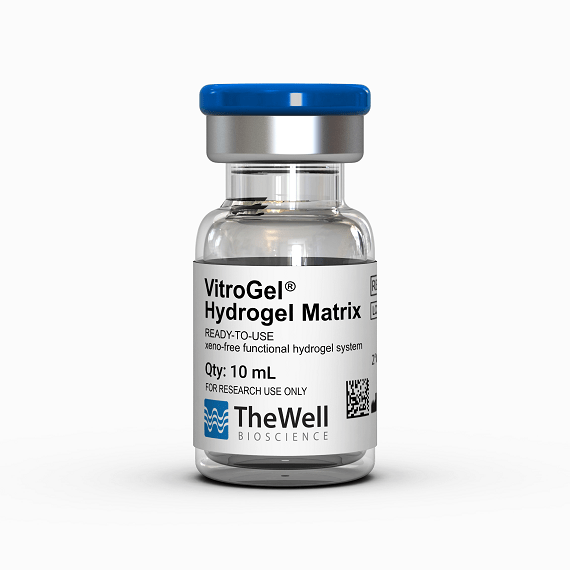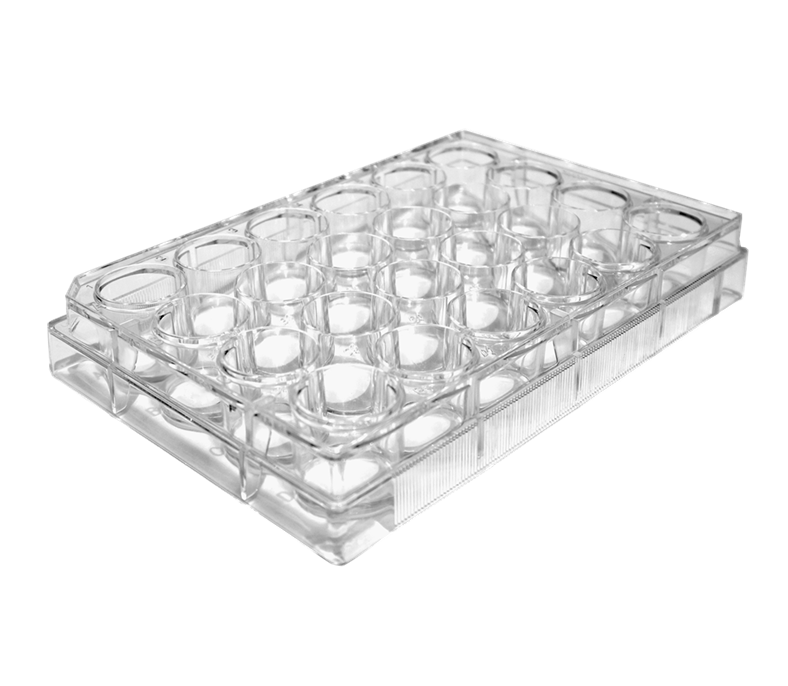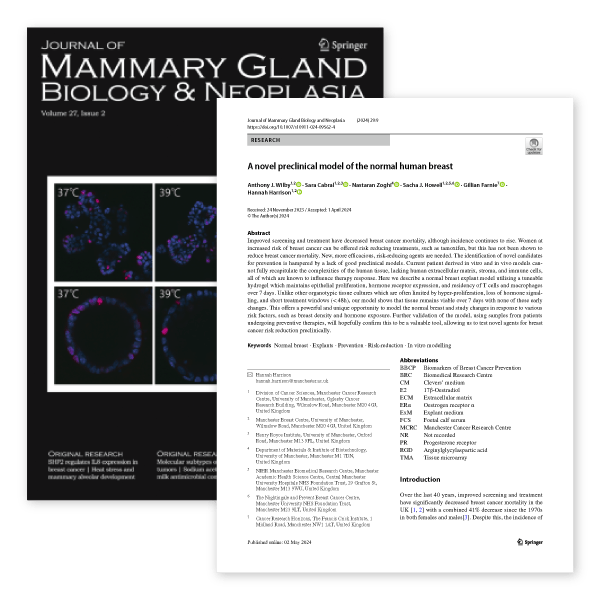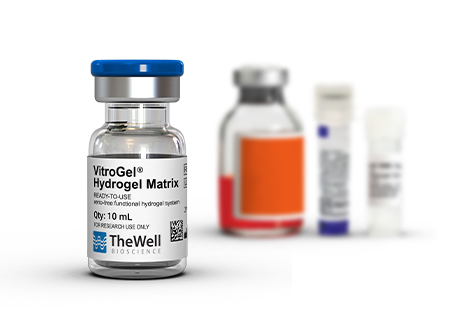Conferences, News
Prevent Breast Cancer Research Conference 2024

Let’s connect at the very first Prevent Breast Cancer Research Conference 2024 in Manchester, UK!
Join us at the first Prevent Breast Cancer Research Conference 2024. Learn about key updates across breast cancer studies and how prediction can change the future of breast cancer diagnoses. The event will take place on September 24th and 25th 2024 at INNSiDE by Melia, Manchester City Centre. Visit our stand and learn how VitroGel® helps to maintain viable organotypic breast tissue cultures without losing phenotype properties.
Schedule a MeetingProduct Highlights:

VitroGel® Hydrogel Matrix (VHM01)
Ready-to-use, xeno-free hydrogel system that supports a wide range of cell types for different applications such as: in vitro 3D models, ex vivo/ co-culture, and in vivo models.
VitroGel® RGD (TWG003, TWG003-2)
Tunable, xeno-free hydrogel system modified with cell adhesive peptide RGD to promote cell attachment and cell-matrix interactions during the 3D cell culture.
The VitroGel®-Based Invasion Assay Kits are powered by VitroGel® hydrogels (versatile, xeno-free, bio-functional hydrogels that closely mimic the physiological extracellular matrix) coupled with our premium quality VitroPrime™ Cell Culture Inserts, allowing more accurate and consistent invasion and migration studies than animal-based ECM.
VitroPrime™ Spread Attach Plates
Unique surface treated for superior hydrogel spreading, adherence,
and uniform surface to eliminate the edge effect, solve the floating issue and uneven cell attachment to help promote rapid cell growth and improve cell yields.
VitroPrime™ Cell Culture Inserts
Closely mimics the in vivo environment to promote enhanced attachment, growth, and differentiation of a wide range of cell types.
Resources:
Application Notes
- Advanced 3D Luminal Breast Cancer Model in VitroGel® System: Long-term 3D Cell Culture and Co-culture with Fibroblast Cells
- Cell Line-Derived Xenograft Using Xeno-Free VitroGel System in Comparison to Animal-based Extracellular Matrix
Research Highlights
- A Novel Pre-Clinical Model of the Normal Human Breast
- A One-Two-Three Punch Against Breast Cancer
- Delivery of Cannabidiol via Extracellular Vesicles Improves the Cytotoxic Effects of Chemotherapy on Triple Negative Breast Cancer Cells
- Estrogen Induces Apoptosis of Breast Cancer Cells in Aromatase Inhibitor Resistant Tumors
- Identification of a Novel Antitumor Small-Molecule Known as MKI-1 via Activation of PP2A in Breast Cancer
- RNF208, an Estrogen-Inducible E3 Ligase, Targets Soluble Vimentin to Suppress Metastasis in Triple-Negative Breast Cancers
- One step closer: ADK-L as a potential therapeutic target for aggressive metastatic breast cancer
- Breaking the (cell) cycle: Introducing CDK9 as a prognostic biomarker and therapeutic target in synovial sarcomas
- B49 and the B(ea)ST: A novel BST-based analog, B49, may prevent breast cancer metastasis by disrupting BST-2 dimerization
Publications
- Wilby, A., Cabral, S., Zoghi, N., Howell, S., Farnie, G., & Harrison, H. (2024). A novel preclinical model of the normal human breast. Journal of Mammary Gland Biology and Neoplasia, 29(9). https://doi.org/10.1007/s10911-024-09562-4
- Li, H., Hou, M., Zhang, P., Ren, L., Guo, Y., Zou, L., Cao, J., & Bai, Z. (2024). Wedelolactone suppresses breast cancer growth and metastasis via regulating TGF-β1/Smad signaling pathway. Journal of Pharmacy and Pharmacology. https://doi.org/10.1093/jpp/rgae065
- Lei, Y., Tian, B.-H., Li, X.-X., Sun, M.-Y., Guo, X.-L., Wang, Y.-D., Zhou, H.-Q., Ma, R.-S., & Liang, H.-X. (2024). Surface charge accumulation of functionalized carbonized polymer dots selectively induces lysosomal membrane permeabilization of breast cancer cells. Chemical Engineering Journal, 494, 152710–152710. https://doi.org/10.1016/j.cej.2024.152710
- East, A. K., Lee, M. C., Jiang, C., Sikander, Q., & Chan, J. (2023). Biomimetic Approach to Promote Cellular Uptake and Enhance Photoacoustic Properties of Tumor-Seeking Dyes. Journal of the American Chemical Society, 145(13), 7313–7322. https://doi.org/10.1021/jacs.2c13489
- Li, H., Shi, W., Shen, T., Hui, S., Hou, M., Wei, Z., Qin, S., Bai, Z., & Cao, J. (2023). Network pharmacology-based strategy for predicting therapy targets of Ecliptae Herba on breast cancer. Medicine, 102(41), e35384–e35384. https://doi.org/10.1097/md.0000000000035384
- Badawe, H. M., Jean Paul Harouz, Raad, P., Abu, K., Freije, A., Ghali, K., Wassim Abou-Kheir, & Khraiche, M. L. (2024). Experimental and Computational Analysis of High-Intensity Focused Ultrasound Thermal Ablation in Breast Cancer Cells: Monolayers vs. Spheroids. Cancers, 16(7), 1274–1274. https://doi.org/10.3390/cancers16071274
- Xu, L., Yang, L., Zhang, D., Wu, Y., Shan, J., Zhu, H., Lian, Z., He, G., Wang, C., & Wang, Q. (2024). Multi-omics analysis reveals the unique landscape of DLD in the breast cancer tumor microenvironment and its implications for immune-related prognosis. Computational and Structural Biotechnology Journal. https://doi.org/10.1016/j.csbj.2024.02.016
- Marcel Janis Beha, Kim, J.-C., San Hae Im, Kim, Y., Yang, S., Ju Hee Lee, Yu Ri Nam, Lee, H., Park, H.-S., & Hyun Jung Chung. (2023). Bioorthogonal CRISPR/Cas9‐Drug Conjugate: A Combinatorial Nanomedicine Platform. Advanced Science, https://doi.org/10.1002/advs.202302253
- Worden, A., Uline, M. J., Shazly, T., Stern, M., & Potts, J. D. (2022). Self-Assembling Toroidal Cell Constructs for Tissue Engineering Applications. Microscopy and Microanalysis, 28(2), 543–552. https://doi.org/10.1017/S1431927622000253
- Surapaneni, S. K., Patel, N., Sun, L., Kommineni, N., Kalvala, A. K., Gebeyehu, A., Arthur, P., Duke, L. C., Nimma, R., G Meckes, D., & Singh, M. (2022). Anticancer and chemosensitization effects of cannabidiol in 2D and 3D cultures of TNBC: involvement of GADD45α, integrin-α5, -β5, -β1, and autophagy. Drug Delivery and Translational Research. https://doi.org/10.1007/s13346-022-01137-2
- Patel, N., Kommineni, N., Surapaneni, S. K., Kalvala, A., Yaun, X., Gebeyehu, A., Arthur, P., Duke, L. C., York, S. B., Bagde, A., Meckes, D. G., & Singh, M. (2021). Cannabidiol loaded extracellular vesicles sensitize triple-negative breast cancer to doxorubicin in both in-vitro and in vivo models. International Journal of Pharmaceutics, 607, 120943. https://doi.org/10.1016/j.ijpharm.2021.120943
- Mori, H., Saeki, K., Chang, G., Wang, J., Wu, X., Hsu, P.-Y., Kanaya, N., Wang, X., Somlo, G., Nakamura, M., Bild, A., & Chen, S. (2021). Influence of Estrogen Treatment on ESR1+ and ESR1− Cells in ER+ Breast Cancer: Insights from Single-Cell Analysis of Patient-Derived Xenograft Models. Cancers, 13(24), 6375. https://doi.org/10.3390/cancers13246375
- Ogino, T., Matsunaga, N., Tanaka, T., Tanihara, T., Terajima, H., Yoshitane, H., Fukada, Y., Tsuruta, A., Koyanagi, S., & Ohdo, S. (2021). Post-transcriptional repression of circadian component CLOCK regulates cancer-stemness in murine breast cancer cells. ELife, 10, e66155. https://doi.org/10.7554/eLife.66155
- Kim, A.-Y., Yoon, Y. N., Leem, J., Lee, J.-Y., Jung, K.-Y., Kang, M., Ahn, J., Hwang, S.-G., Oh, J. S., & Kim, J.-S. (2020). MKI-1, a Novel Small-Molecule Inhibitor of MASTL, Exerts Antitumor and Radiosensitizer Activities Through PP2A Activation in Breast Cancer. Frontiers in Oncology, 10. https://doi.org/10.3389/fonc.2020.571601
- Pang, K., Park, J., Ahn, S. G., Lee, J., Park, Y., Ooshima, A., Mizuno, S., Yamashita, S., Park, K.-S., Lee, S.-Y., Jeong, J., Ushijima, T., Yang, K.-M., & Kim, S.-J. (2019). RNF208, an estrogen-inducible E3 ligase, targets soluble Vimentin to suppress metastasis in triple-negative breast cancers. Nature Communications, 10(1), 5805. https://doi.org/10.1038/s41467-019-13852-5
- Shamloo, B., Kumar, N., Owen, R. H., Reemmer, J., Ost, J., Perkins, R. S., & Shen, H.-Y. (2019). Dysregulation of adenosine kinase isoforms in breast cancer. Oncotarget, 10(68). https://doi.org/10.18632/oncotarget.27364
- Mahauad-Fernandez, W. D., Naushad, W., Panzner, T. D., Bashir, A., Lal, G., & Okeoma, C. M. (2018). BST-2 promotes survival in circulation and pulmonary metastatic seeding of breast cancer cells. Scientific Reports, 8(1). https://doi.org/10.1038/s41598-018-35710-y
- Kampert, Taylor. (2018). Combinatorial therapy for triple negative breast cancer and the effect of nanoscale surfaces. https://www.ideals.illinois.edu/handle/2142/101367(1). https://doi.org/10.1038/s41598-018-35710-y
- Mahauad-Fernandez, W. D., & Okeoma, C. M. (2018). B49, a BST-2-based peptide, inhibits adhesion and growth of breast cancer cells. Scientific Reports, 8(1). https://doi.org/10.1038/s41598-018-22364-z
Explore our xeno-free, easy-to-use, and biofunctional VitroGel® hydrogel system and all its advantages over animal-based ECMs.
VitroGel® offers a defined synthetic hydrogel system that closely mimics the natural ECM environment without animal or human components. This system gives researchers control over mechanical strength, functional ligands, and degradability, allowing for the creation of precise biomimetic environments tailored for various applications in drug discovery, tissue engineering, and cell therapy.
In contrast, animal-based ECMs suffer from batch-to-batch inconsistency and contain over 2,000 undefined components, highlighting the superior consistency and defined nature of the VitroGel® system for advanced biomedical research and development.
Learn The Difference Between VitroGel® vs. Animal-Based ECM >
Talk to Us!
Interested in scheduling a dedicated time with our team at the first Prevent Breast Cancer Research Conference 2024 or unable to attend the conference? Please complete the form and our dedicated team will be delighted to assist you with any inquiries. We look forward to connecting with you and addressing your specific needs.









